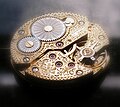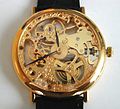Finissage (clock)
The finissage is a final refinement process on a clockwork . In addition to the technical refinement through numerous additional functions, mechanical post-processing (including finishing, finishing, French finishing ) by a finisher is a quality feature of movements and cases of wrist and pocket watches . The finissage is defined for receiving the Geneva hallmark as a quality feature and marketing argument.
First and foremost, it is a surface treatment of the components of the work using special grinding techniques such as Geneva stripes (rib-shaped decoration applied to bridges and cocks before electroplating ; synonymous with Glashütte stripes ), pearl cut (French: perlage ) or sunburst , as well as embossing , laser sintering , chiselling , engraving techniques as guilloshing and a burr removal (French. Anglage ) on drives , gears , cocks , bridges and on the bottom plate of the movement. Also common are gold plating , rhodium plating and polished, burnished or blued screws, screwed mounts of jewels made of gold (French chatons ), as well as an only partial technical use of synthetic rubies .
With the preparation of the pocket Marie-Antoinette by Abraham Louis Breguet with its transparent dial from rock crystal (so-called. Open dial ) could see the details of processing, which required a complicated Finissage.
When the work is skeletonized , all of the rigid parts are subsequently broken through, except for what is mechanically necessary, so that one can see through the work. In the case of a skeleton watch, elaborate payments are usually visible through a glass bottom and a missing or reduced dial.
With a minimal work plate design, on the other hand, the mechanically unnecessary gaps are left out from the design of the movement, which allows the use of specific motifs as the work plate, e.g. For example, the Master Eight Days Perpetual Squelette by Jaeger-LeCoultre , the tourbillon with three bridges by Girard-Perregaux or the Freak by Ulysse Nardin .
photos
Minimal figurative work plate
literature
- Otto Böckle, Wilhelm Brauns: Textbook for the watchmaking trade. Work skills and materials. 8-10 Edition. Wilhelm Knapp, Halle (Saale) 1951 (reprint, edited by Michael Stern. Heel, Königswinter 2010, ISBN 978-3-86852-288-4 ).
- Hermann Brinkmann: Introduction to watchmaking (= The watchmaking school. Vol. 2). 10th unchanged edition. Wilhelm Knapp, Düsseldorf 2005, ISBN 3-87420-010-8 .
- George Daniels : Watchmaking. Updated 2011 edition. Philip Wilson Publishers, London 2011, ISBN 978-0-85667-704-5 .
Individual evidence
- ↑ Georges-Albert Berner: Illustrated specialist dictionary of watchmaking. Retrieved January 9, 2012.
- ^ Canton of Geneva: Règlement sur le contrôle facultatif des montres de Genève (RCFM). Retrieved January 5, 2012.
- ^ Helmut Kahlert , Richard Mühe , Gisbert L. Brunner , Christian Pfeiffer-Belli: wrist watches: 100 years of development history. Callwey, Munich 1983; 5th edition, ibid 1996, ISBN 3-7667-1241-1 , p. 504.
- ↑ Rob Berkavicius: 100 Jewels - 83 Jewels too many? Timezone Watch Forum ( Memento from July 2, 2008 in the Internet Archive ). Retrieved November 11, 2011.







